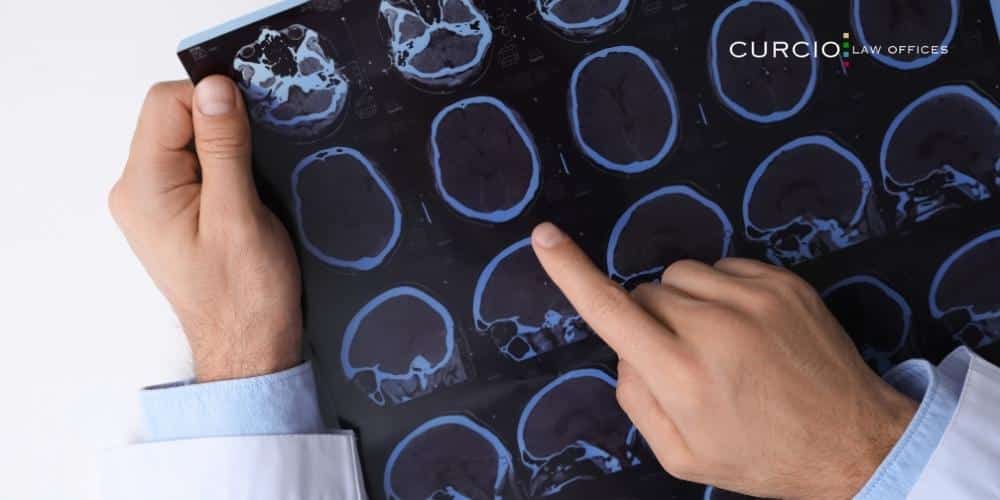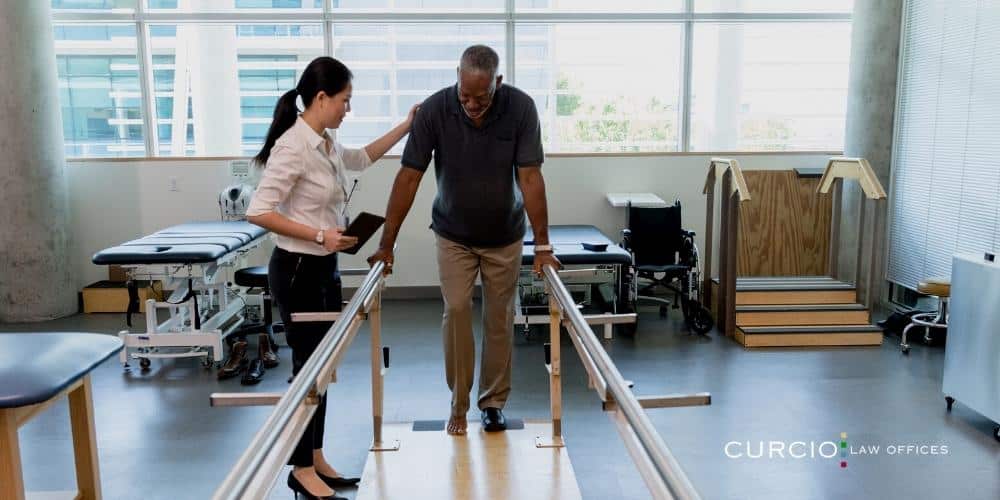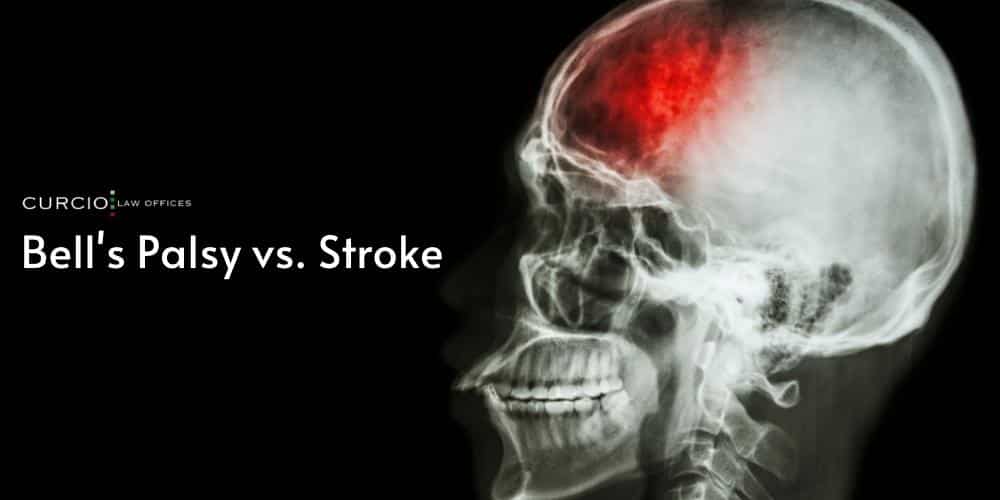Both a stroke and Bell’s Palsy have one scary symptom in common: facial weakness and paralysis. Experiencing central or lower facial weakness is terrifying, especially knowing what we know about stroke complications and mortality rates. That’s why the Chicago personal injury attorneys at Curcio & Casciato are breaking down symptoms, causes, and treatments of Bell’s Palsy vs. stroke.
If you or someone you love has suffered a stroke from medical malpractice or a motor vehicle accident, you may have grounds to file a lawsuit. Additionally, if you or someone you love has received a misdiagnosis and/or delayed treatment for stroke (which results in permanent disability or wrongful death) you may also have grounds to sue. Chicago personal injury lawyers at Curcio & Casciato will carefully examine the facts of your case and help you determine the best course of action. Call 312-321-1111 to schedule a free consultation today.
What is Bell’s Palsy?
Bell’s Palsy is a non-life threatening condition that causes a rapid onset of temporary facial paralysis. Most commonly, Bell’s Palsy patients will generally experience facial paralysis, or noticeable facial drooping, on only one side of the face. More rarely, a Bell’s Palsy patient can experience full facial paralysis.
Bell’s Palsy is the most common cause of paralysis of the facial muscles according to the National Institute of Neurological Disorders and Stroke. Bell’s palsy affects approximately 40,000 Americans every year. Anyone of any age and gender can experience this disorder. However, Bell’s Palsy is most common among people aged 15 to 45.
Bell’s Palsy Symptoms
When Bell’s Palsy occurs, patients may experience the following symptoms:
- Facial weakness and paralysis on one or both sides of the face. This generally happens over the course of a few hours to a few days.
- Difficulty making any facial expression
- Difficulty closing the eye or smiling on the affected side of the face
- Drooling and excess saliva production
- Headache
- Loss of taste
- Watery eyes
- Pain and ringing in one or both ears
- Jaw pain
- Difficulty eating
What Causes Bell’s Palsy?
Doctors and scientists aren’t completely sure what causes this disorder. They do know that people with acute facial paralysis generally have an inflamed seventh cranial nerve, which is basically a facial nerve. This facial nerve controls a lot of things, such as your facial expressions, your tear glands, your saliva glands, and even your sensation of taste.
Some health experts believe that Bell’s Palsy is caused by a reactivation of a pre-existing viral infection. Listed below are the viruses that have been linked to cases of Bell’s Palsy:
- Herpes simplex (cold sores and genital herpes)
- Herpes zoster (chickenpox and shingles)
- Epstein-Barr virus (infectious mononucleosis)
- Adenovirus (respiratory illnesses such as common colds and flus)
- Rubella (German measles)
- Mumps virus
- Influenza B
- Coxsackievirus (hand, foot, and mouth disease)
- Cytomegalovirus (CMV) infections
The theory is that one or more of these viruses can cause one of the facial nerves to become swollen, therefore resulting in facial weakness and drooping. Health experts also believe that weakened immune systems from stress, lack of sleep, autoimmune diseases, and even physical injuries can lead to Bell’s Palsy as well.
Lastly, pregnancy has been known to trigger Bell’s Palsy symptoms in some women. Most pregnant women experience this sudden weakness and paralysis in the face in the third trimester. A 2000 study claims that Bell’s Palsy during pregnancy may be caused by viral inflammation, immunosuppression, and/or high extracellular fluid content. Meanwhile, other health experts believe that preeclampsia can cause Bell’s Palsy during pregnancy.
Bell’s Palsy Treatment
In many cases, the temporary paralysis of the face associated with Bell’s Palsy clears up with very minimal treatment over the course of a few weeks to a few months. Many doctors will prescribe steroids to reduce facial nerve inflammation and to increase the probability of a full recovery. Some doctors believe that antiviral medications may also aid in Bell’s Palsy recovery. If the patient is having jaw or ear pain, their doctor may also prescribe them pain medications.
Most Bell’s Palsy patients regain full control of their face with no facial nerve damage. However, there are rare cases where people have permanent nerve damage, irregular regrowth of nerve fibers, and partial or complete blindness of the eye that wouldn’t close during the condition.

What is a Stroke?
Unlike Bell’s Palsy, a stroke is a medical emergency. A stroke is a type of brain injury that occurs when the blood flow to part of the brain is cut off. Lack of blood supply means lack of oxygen and nutrients to the brain. This means that brain cells can begin dying within only a few minutes. In order to have the highest chance of survival and full recovery, stroke patients must receive emergency medical intervention.
The CDC claims that nearly 800,000 Americans suffer a stroke every year. Additionally, about 1 in 4 strokes (185,000 strokes) occur in people who have previously survived a stroke. According to the American Stroke Association, stroke is the 5th leading cause of death in the U.S. and one of the most common causes of lifelong disability.
Types of Strokes
There are three main types of strokes: an ischemic stroke, a hemorrhagic stroke, and a transient ischemic attack.
- Ischemic Stroke is the most common type of stroke in the U.S., with approximately 87% of all annual strokes being acute ischemic strokes. An acute ischemic stroke occurs when a blood clot clogs a blood vessel and therefore restricts blood flow to the brain.
- Hemorrhagic Stroke occurs when a weakened blood vessel ruptures and prevents enough blood from getting to the brain.
- Transient Ischemic Attack (TIA) is also called a “mini stroke.” A mini stroke is generally caused by a temporary clot that restricts blood flow to the brain.
Stroke Symptoms
Common stroke symptoms include:
- Central facial weakness, AKA: facial droop on one side
- Paralysis or weakness of one arm or leg
- Slurred speech and general difficulty speaking
- Double vision
- Difficulty walking
- General confusion
- Difficulty understanding what people are saying
- Sudden, severe headache
- Dizziness
- Loss of coordination and balance
- Other focal neurologic deficits
What Causes a Stroke?
According to the CDC, the leading causes of strokes are high cholesterol, high blood pressure, obesity, diabetes, and smoking.
More uncommonly, a stroke can occur due to some kind of traumatic accident such as a car accident, a truck accident, a pedestrian accident, a motorcycle accident, or even a violent assault. But these accidents are more likely to cause a hemorrhagic stroke.
Additionally, severe incidences of chiropractor malpractice have been known to cause a ruptured blood vessel or artery. This is called vertebral artery dissection (VAD), and it can easily turn into a stroke if a blood clot develops at the ruptured artery and then travels to the brain.
This happened very recently and received national attention. According to a 2022 news report, a Georgia woman suffered 4 torn arteries in her neck from a chiropractor manipulating her cervical spine incorrectly. Her case of VAD turned into a stroke and cardiac arrest. These complications caused her heart to stop for 10 minutes, which prevented proper blood supply from reaching her brain. Once she was revived, her doctors declared that she had suffered a traumatic brain injury and partial paralyzation.
Stroke Treatment
If you or someone you love is exhibiting stroke symptoms, you should call 911 immediately. Prompt medical treatment is crucial for survival and preventing lifelong disability from a traumatic brain injury. Treatment will heavily depend on the type of stroke occurring.
For an ischemic stroke, doctors may try emergency IV medication to break up the blood clot or perform an emergency endovascular procedure directly inside the blood vessel that’s clogged.
For a hemorrhagic stroke, doctors may administer emergency medications to lower intracranial pressure and prevent seizures. Doctors may also perform various surgical procedures to remove the blood pooling in the brain, relieve intracranial pressure, and repair the ruptured blood vessel.
Bell’s Palsy vs. Stroke
The main differences between Bell’s Palsy and stroke are symptoms, symptom onset, whether or not the brain is affected, and whether or not it’s a life-threatening condition. We all know by now that Bell’s Palsy can mimic stroke with a facial droop. However, if the patient isn’t also experiencing slurred speech, weakness or paralysis in other parts of the body, confusion, headache, and more, then the issue is more likely to be Bell’s Palsy.
Another main difference between Bell’s Palsy vs. stroke is symptom onset. In both conditions, symptoms will start fairly quickly. However, Bell’s Palsy symptoms are more likely to develop at a slower pace, over the course of a couple of days. Meanwhile, stroke symptoms begin immediately (within a few minutes to a few hours) with symptoms reaching maximum severity in only a few minutes.
Another difference between Bell’s Palsy and stroke is that Bell’s Palsy does not affect the brain at all. Instead, it affects the facial nerves. Stroke, on the other hand, directly affects the brain because it’s cutting off blood flow one way or another. That’s what makes the condition so dangerous.
Lastly, Bell’s Palsy is not a life-threatening condition. It’s certainly concerning at first, but once doctors figure out it’s Bell’s Palsy and not a stroke, most patients can fully recover within a few weeks to a few months. Meanwhile, a stroke is a medical emergency that can result in permanent brain damage, paralysis, and even death if the condition isn’t treated immediately.

Call Chicago Personal Injury Lawyers at Curcio & Casciato Today
If you or someone you love has suffered a stroke from a motor vehicle accident or a medical malpractice incident, you may have grounds to pursue financial compensation from the at-fault party. Our team of Chicago personal injury lawyers have decades of combined experience in fighting for justice for our injured clients. We can help you recover the financial assistance you need to pay for medical bills, long-term caregiving expenses, lost wages, and so much more. Call 312-321-1111 to schedule a free consultation with us today.



